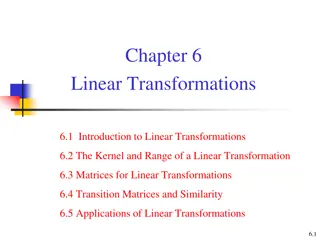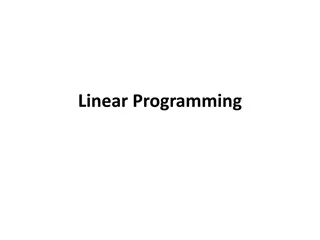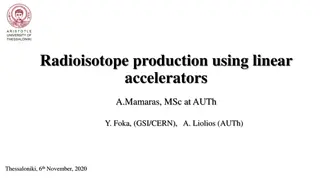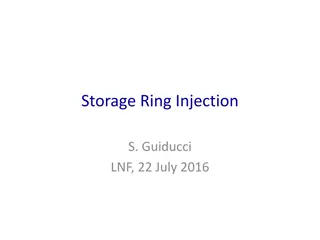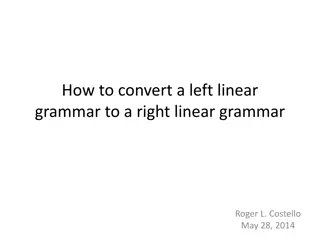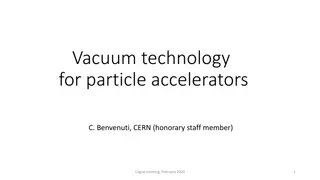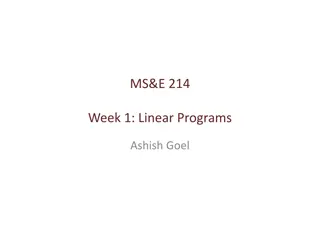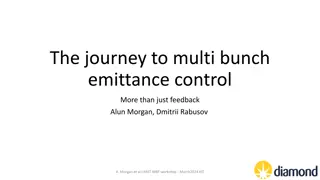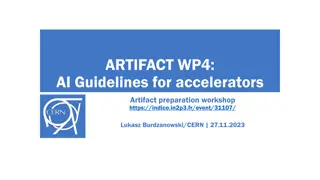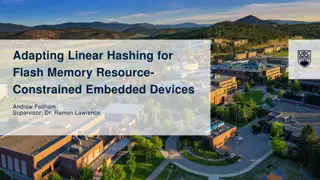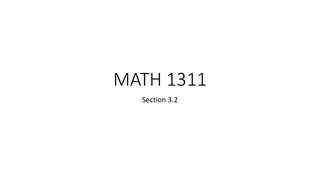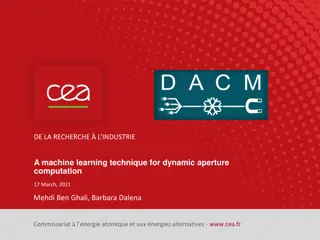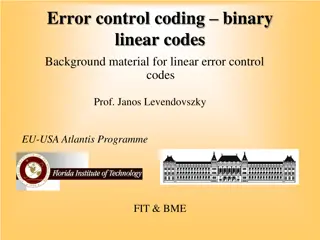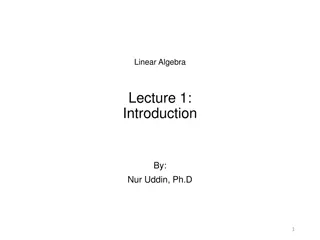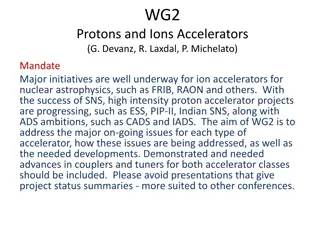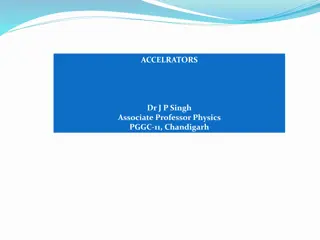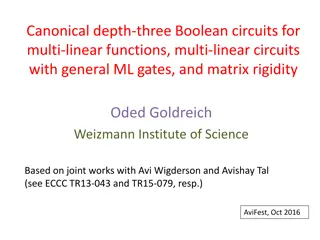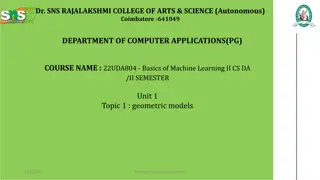Building a FAIR-Compliant Platform for AI-Ready Data in Particle Accelerators
This content discusses the development of a FAIR-compliant platform for AI-ready data in particle accelerators, highlighting the applications of machine learning in various accelerator facilities like CERN, PETRA-III, NSLS-II, HEPS, and more. It emphasizes the importance of high-quality data in acce
5 views • 25 slides
Overview of Particle Accelerators and Isotope Production Methods
Explore various types of particle accelerators such as Direct Voltage Accelerators, Van de Graaff Generators, Tandem Van de Graaff Accelerators, and Linear Accelerators used in generating particles for isotope production, research, and industrial applications. These technologies play a crucial role
6 views • 22 slides
Linear Discrimination for Classification
Linear discrimination is a method for classifying data where examples from one class are separable from others. It involves using linear models or high-order functions like quadratic to map inputs to class separable spaces. This approach can be further categorized as class-based or boundary-based, e
5 views • 37 slides
Linear Reservoir Baseflow Method
The linear reservoir baseflow method utilizes linear reservoirs to simulate the movement of water infiltrated into the soil. This method models water movement from the land surface to the stream network by integrating a linear relationship between storage and discharge. Users can select from one, tw
3 views • 11 slides
Linear Transformations and Matrices in Mathematics
Linear transformations play a crucial role in the study of vector spaces and matrices. They involve mapping vectors from one space to another while maintaining certain properties. This summary covers the introduction to linear transformations, the kernel and range of a transformation, matrices for l
4 views • 85 slides
Sustainable Accelerators Workshop by ASTeC at STFC Daresbury Laboratory
ASTeC at STFC Daresbury Laboratory is hosting a workshop on improving the sustainability of particle accelerators, aiming to bring together scientists, engineers, and stakeholders to enhance current and future accelerator sustainability. The agenda includes discussions on reducing emissions, green t
3 views • 5 slides
Linear Programming: An Introduction to Optimization
Linear programming, introduced by mathematician George B. Dantzig in 1947, is a mathematical technique for optimizing resource allocation in a systematic manner. It involves formulating linear relationships among variables to achieve desired results like cost minimization or profit maximization. Lin
5 views • 60 slides
Comprehensive Overview of Numerical Linear Algebra Methods for Solving Linear Systems
Explore numerical linear algebra techniques for solving linear systems of equations, including direct and iterative methods. Delve into topics like Gaussian elimination, LU factorization, band solvers, sparse solvers, iterative techniques, and more. Gain insights into basic iterative methods, error
9 views • 12 slides
Advancements in Radioisotope Production Using Linear Accelerators for Medical Imaging
Exploring the potential of linear accelerators for producing radioisotopes used in PET imaging, this comprehensive study delves into the efficiency and cost-effectiveness of utilizing linac-based systems. Key considerations include accelerator designs, production yield estimations, and numerical cal
2 views • 12 slides
Linear Dependent and Independent Vectors
In linear algebra, when exploring systems of linear equations and vector sets, it is crucial to distinguish between linear dependent and independent vectors. Linear dependence occurs when one vector can be expressed as a combination of others, leading to various solutions or lack thereof in the give
5 views • 20 slides
Injection Process in Particle Accelerators
The injection process in particle accelerators involves transferring beams efficiently with minimal loss and emittance dilution. It includes on-axis injection onto the reference orbit using septum magnets and fast kickers to maintain beam trajectory accuracy. The design aims to achieve precise beam
3 views • 22 slides
Converting Left Linear Grammar to Right Linear Grammar
Learn about linear grammars, left linear grammars, and right linear grammars. Discover why left linear grammars are considered complex and how right linear grammars offer a simpler solution. Explore the process of converting a left linear grammar to a right linear grammar using a specific algorithm.
5 views • 44 slides
Vacuum Technology for Particle Accelerators
This presentation covers the importance of vacuum technology in particle accelerators, focusing on particle loss due to collisions with residual gas molecules and the stringent vacuum requirements for storage rings and accelerators. It discusses the impact of circulating beams on vacuum deterioratio
1 views • 37 slides
Linear Optimization in MS&E 214
Linear optimization involves maximizing or minimizing a linear function subject to constraints. This week's focus in MS&E 214 is on linear programming, basic feasible solutions, duality theory, and extreme point solutions. The concept of linear programs, such as the example of maximizing x + 3y subj
5 views • 36 slides
Enhancing Emittance Control Strategies in Particle Accelerators
The journey to multi-bunch emittance control goes beyond mere feedback mechanisms, involving nuances like pinhole cameras as detectors and skew quadrupole magnets as actuators. This innovative approach aims to overcome limitations of existing systems like coupling control issues and hysteresis perfo
6 views • 16 slides
Transverse Motion in Particle Accelerators
Exploring the formalism and calculations related to transverse motion in particle accelerators, including the Hill equation, transfer matrices, lattice functions, and example drift calculations. The content delves into the mathematical foundations and practical applications of analyzing particle bea
3 views • 16 slides
Tradeoffs in Coherent Cache Hierarchies for Accelerators
Explore the design tradeoffs and implementation details of coherent cache hierarchies for accelerators in the context of specialized hardware. The presentation covers motivation, proposed design, evaluation methods, results, and conclusions, highlighting the need for accelerators and considerations
4 views • 22 slides
AI Guidelines for Accelerators: Workshop Summary
Workshop summary on AI guidelines for accelerators focusing on achieving interoperability, leveraging AI solutions, and enabling accelerators to function as autonomous machines. The document contains principles and work breakdown for developing functional guidelines applicable to various domains bey
1 views • 10 slides
Adapting Linear Hashing for Flash Memory Constrained Embedded Devices
This research explores the adaptation of linear hashing for improved data handling on flash memory-constrained embedded devices. Motivated by the increasing data collection by IoT devices, the study focuses on implementing database structures like a linear hash table for efficient data processing. T
2 views • 67 slides
Linear Functions in Mathematics
Linear functions play a crucial role in mathematics, focusing on elements like rate of change and initial value. Through examples involving daily car rental costs and profit from selling birdhouses, this content explores the concept of linear functions and how they are applied in real-life scenarios
3 views • 13 slides
Machine Learning Technique for Dynamic Aperture Computation in Circular Accelerators
This research presents a machine learning approach for computing the dynamic aperture of circular accelerators, crucial for ensuring stable particle motion. The study explores the use of Echo-state Networks, specifically Linear Readout and LSTM variations, to predict particle behavior in accelerator
4 views • 17 slides
Linear and Nonlinear Functions in Mathematics
Explore the concepts of linear and nonlinear functions in mathematics through identifying linear and nonlinear functions from graphs, understanding the characteristics of linear functions, and identifying linear functions from tables. Learn about the constant rate of change, slope, and how to determ
2 views • 49 slides
Linear Error Control Coding and Syndrome Detection in Binary Linear Codes
Delve into the world of linear error control coding, guided by Prof. Janos Levendovszky, as we explore the development of linear codes, message vectors, error groups, and the process of selecting group leaders with detailed examples. Discover how syndrome detection and decoding tables play a crucial
3 views • 27 slides
Introduction to Linear Algebra: Syllabus, Examples, and Solutions
Delve into the fundamentals of linear algebra through a series of lectures and examples by Nur Uddin, Ph.D. Explore the application of linear algebra in daily life scenarios, solving linear equations and systems, matrices multiplication, and more. Understand the concept of linear systems, solutions,
4 views • 24 slides
Branch-Aware Loop Mapping on Coarse-Grained Reconfigurable Accelerators
Increase performance at lower power vs. utilization with hardware accelerators like DSPs, GPUs, FPGAs, and CGRAs. Learn about branch divergences' impact on resource utilization in accelerators, control flow acceleration, and the benefits of coarse-grained reconfigurable accelerators. Explore loop ac
3 views • 15 slides
Branch-Aware Loop Mapping on Coarse-Grained Reconfigurable Accelerators
Increase performance at lower power by leveraging hardware accelerators and exploring solutions such as coarse-grained reconfigurable accelerators for efficient resource utilization and control flow acceleration. Learn about loop acceleration, predication techniques, dual-issue architecture, and ker
5 views • 39 slides
Checking Linear Independence in Vectors
Determining linear independence in a set of vectors involves checking if any vector can be expressed as a linear combination of others. This process involves identifying non-zero solutions for a system of linear equations, examining reduced row-echelon form matrices, and understanding the column cor
3 views • 12 slides
Major Initiatives in Protons and Ions Accelerators
Mandate initiatives underway for ion accelerators in nuclear astrophysics like FRIB and RAON. Progress on high-intensity proton accelerator projects such as ESS, PIP-II, Indian SNS, and ADS ambitions like CADS. Addressing ongoing issues, developments in couplers, tuners, and more for both types of a
1 views • 4 slides
Border Control: Accelerators for Host Memory Safety
This presentation discusses Border Control, a system providing host memory safety for accelerators, protecting against bugs and malicious designs. The concept of accelerators, their programmability, and threats they pose are explored. The importance of the Principle of Least Privilege in hardware co
4 views • 36 slides
Longitudinal Particle Motion in Accelerators
Explore the concepts of longitudinal motion in particle accelerators, including acceleration in periodic structures, slip factors, phase stability, longitudinal acceleration, and phase stability analysis. Dive into the intricate details of synchrotron motion and synchrotron tune to enhance your unde
3 views • 25 slides
Linear Accelerators and Cyclotrons: Principles and Advantages
Discover the principles and advantages of linear accelerators and cyclotrons in the field of particle acceleration. Linear accelerators use alternating electric fields, while cyclotrons accelerate charged particles in circular paths by dropping them over potential differences. Both have distinct adv
5 views • 18 slides
Canonical Depth-Three Boolean Circuits for Multi-Linear Functions and Matrix Rigidity
Explore the study of canonical depth-three Boolean circuits for multi-linear functions, multi-linear circuits, and matrix rigidity with a focus on stronger circuit models and lower bounds. Consider multi-linear functions and depth-three circuits to improve circuit complexity. Discover explicit t-lin
2 views • 25 slides
Particle Accelerators: Course Essentials by Eric Prebys at FNAL
Explore a comprehensive course on particle accelerators led by Eric Prebys from FNAL. Delve into the foundations, operations, challenges, and technologies of accelerators, aiming to equip you for advanced studies in this field. Get insights on the intense two-week curriculum, course structure, and r
0 views • 9 slides
Geometric Models in Machine Learning: Understanding Linear & Non-linear Approaches
Explore the realm of geometric models in machine learning, where linear models like Linear Regression and SVM coexist with distance-based models such as KNN and K-Means Clustering. Delve into Manifold Learning techniques like PCA, t-SNE, and UMAP that handle non-linear data structures with finesse,
12 views • 10 slides
Key Aspects Reviewed During Each Stage of Licensing a Linear Accelerator
After this section, students should understand the key aspects reviewed during each stage of licensing a linear accelerator. Regulators should know where and when linear accelerators are installed, what training users have, what they are used for, how they are maintained, and how quality is managed
4 views • 10 slides
Converting Left Linear Grammar to Right Linear Grammar
Learn how to convert a left linear grammar to a right linear grammar. Understand the concepts of linear grammars, left linear grammars, and right linear grammars. Discover why left linear grammars are considered complex and why right linear grammars are more favorable. Explore the algorithm used for
3 views • 44 slides
Self-Focusing Bunches for High Brightness Acceleration
Explore the concept of self-focusing bunches for high brightness acceleration in particle accelerators. Learn about beam loading effects, linear regimes, transverse contributions, and energy spread growth for high-quality acceleration. Witness transverse matching, beam loading compensation, and impo
1 views • 13 slides
Accelerator Workshop Insights
Explore the world of accelerators through workshops covering topics like beam physics, particle dynamics, and accelerator domains. Learn about the delivery of accelerators and the importance of beams for users. Discover the intricacies of particles in accelerators and their behavior along specific t
2 views • 24 slides
Understanding RF Linear Accelerators Coupling Mechanisms
Explore the intricate coupling mechanisms of RF linear accelerators, including electric and magnetic coupling, resonant circuits, bandwidth considerations, impedance calculations, and coupler configurations. Delve into the detailed concepts presented by Dr. Graeme Burt from Lancaster University.
0 views • 35 slides
RF Linear Accelerators: Coupling & Resonance Dynamics
Explore the intricate details of RF linear accelerators, including coupling mechanisms to standing wave cavities, electric and magnetic coupling principles, resonant circuits, resonant bandwidth, cavity impedance, and more. Learn about the complexities of coupling probes, loops, parallel resonant ci
0 views • 35 slides




